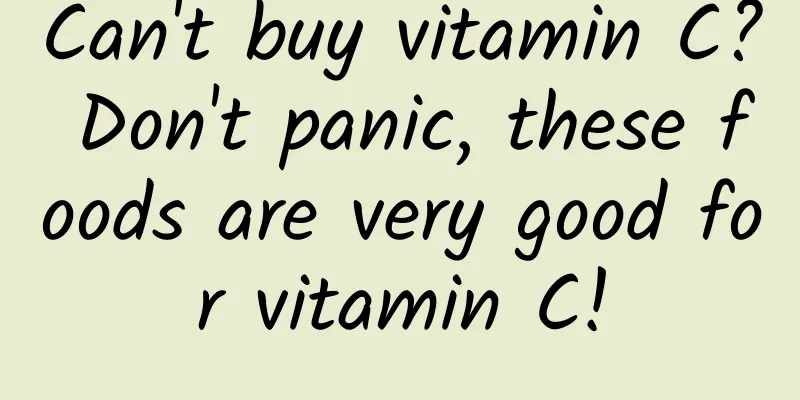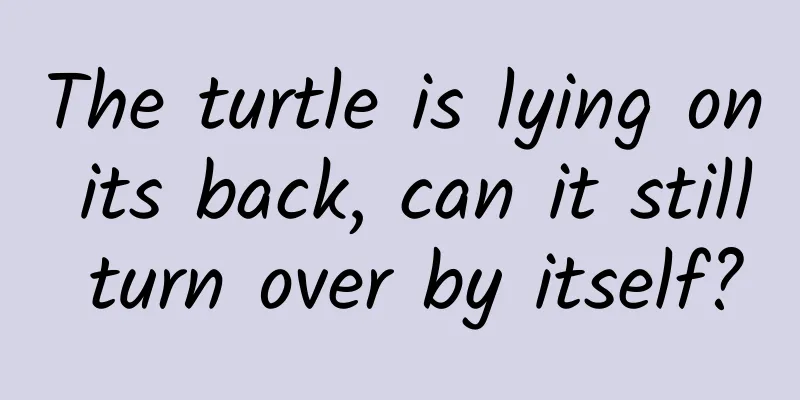Can't buy vitamin C? Don't panic, these foods are very good for vitamin C!

|
With the relaxation of new epidemic prevention policies, everyone's health is in their own hands. Big data experts have also used data to deduce the peak of the first round of infections in various places. The epidemic prevention situation is still very serious. How to improve immunity, arm yourself before the virus attacks, and better enhance the ability to resist disease is currently the issue that everyone is most concerned about. When it comes to immunity, the first thing that comes to mind is to supplement vitamin C. However, it is almost impossible to buy cost-effective vitamin C tablets at many pharmacies. Even if there is vitamin C, it is hundreds of yuan a bottle, which is very expensive. It doesn't matter, don't worry, many foods are also rich in vitamin C, and the vitamin supplement effect is also very strong. Tuchong Creative 01 Natural Vitamin C or Synthetic Vitamin C, Which is Better? Natural vitamin C is the vitamin C component that exists naturally in food, while synthetic vitamin C is vitamin C artificially prepared by chemical synthesis and other methods. These two types of vitamin C have exactly the same structure and are derived from ascorbic acid,[1] so from the perspective of vitamin C supplementation alone, either one is fine. But the difference is that natural foods contain not only vitamin C, but also biologically active substances, such as carotenoids, alkaloids, anthocyanins, sulfur-containing compounds and vitamin E. These bioactive substances not only have antioxidant and free radical scavenging capabilities, but can also work synergistically with vitamin C to enhance the biological activity of vitamin C. For example, anthocyanins can prevent vitamin C from oxidizing and protect vitamin C. The DPPH free radical scavenging rate of the two is more than twice that of vitamin C alone. Vitamin E can also work synergistically with vitamin C to enhance antioxidant capacity. [1] Therefore, compared with synthetic vitamin C, supplementing natural vitamin C through food can also be antioxidant and scavenge free radicals, which can reduce the risk of chronic diseases. It also has anti-inflammatory effects, increases the absorption rate and bioavailability of vitamin C, and better enhances immunity. Tuchong Creative 02 These foods are very rich in vitamin C vegetable-- Bell peppers and colored peppers: They are both rich in vitamin C. The vitamin C content of bell peppers and colored peppers is as high as 130 mg/100 g and 104 mg/100 g, respectively. [2] This means that eating 100 grams of bell peppers or colored peppers can meet 130% and 104% of an average adult's daily vitamin C needs. Moreover, both of them can be eaten raw, have a sweet taste, better retain nutrients, and avoid the loss of vitamin C during the cooking process. When purchasing, try to choose those with plump and shiny skin. Those with wispy skin are mostly because they have been stored for too long and are no longer fresh, and the nutrients will be lost. Chinese cabbage: The vitamin C content of Chinese cabbage is quite good among green leafy vegetables, which is 64 mg/100 g. Try to choose low-temperature cooking, such as stir-frying over high heat, Chinese cabbage soup, or blanching it in boiling water and then serving it cold, so that more vitamin C can be retained. Kale: This vegetable looks good and is mostly found in flower beds. It contains 63 mg/100 g of vitamin C, which is higher than broccoli, which is also a cruciferous vegetable, and 1.7 times that of Chinese cabbage. It is also rich in beta-carotene, which can be converted into vitamin A in the body and is good for eye health. However, kale is high in dietary fiber and contains glucosinolates, which make it taste rough and bitter. Many people don't like to eat it, but in fact, the taste will be much better if you blanch it in boiling water. If you can't chew the stems, don't eat it. Cherry tomatoes: also known as cherry tomatoes, have a vitamin C content of 33 mg/100 g, which is 2.4 times that of large tomatoes. Eating about 15 cherry tomatoes can almost meet 66% of the daily vitamin C needs of an average adult. And it is super convenient to eat, just wash it and eat it in one bite! Tuchong Creative fruit-- Winter jujube: The vitamin C content is quite considerable, 243 mg/100 g. Even if you only eat two or three winter jujubes, you can meet your daily vitamin C needs. However, winter jujubes are high in calories, so if you want to lose weight, don't eat too much. Kiwi: Kiwis have a sweet and sour taste and contain 62mg/100g of vitamin C. Although not as good as winter dates, eating 1-2 kiwis a day can almost meet the daily vitamin C requirement , and the price is not expensive. Strawberry: The vitamin C content of strawberry is as high as 47 mg/100 g, which is nearly twice that of grapes . Strawberry is a low-calorie, low-GI fruit, very suitable for friends who need to lose weight and control blood sugar. Orange: The vitamin C content is 53.2 mg/100 g. Eating 1 to 2 fresh oranges can meet the daily vitamin C needs of the general population. However, oranges are also rich in beta-carotene. Eating too many will turn you into a minion, but it is not harmful to your health and you will recover as long as you stop consuming them for a few days. 03 Is it better to take more vitamin C? Tuchong Creative Although vitamin C supplementation is helpful in improving immunity, the more you take, the better. According to the data in the "Chinese Dietary Nutrient Reference Intake 2013 Edition", the recommended daily intake of vitamin C for ordinary adults in China is 100 mg. Some studies have also shown that taking 200 mg of vitamin C per day is very safe and can prevent non-communicable chronic diseases. Although no adverse effects have been found with long-term intake of 1000 mg/day of vitamin C, studies have found that daily intake of more than 2000 mg of vitamin C can cause osmotic diarrhea, and more than 3000 mg/day can cause diarrhea and gastrointestinal disorders, and increase the risk of kidney stones. [3] Therefore, taking too much vitamin C will cause harm to the body, and the maximum tolerable intake is 2000 mg per day. For most of us, there is no need to supplement too much vitamin C, and it is enough to take the recommended amount of 100 mg/day. 04 Summarize If you want to enhance your resistance to disease, you naturally need vitamin C. We need to remind you not to supplement blindly. Many natural foods are rich in vitamin C, which is economical and effective. If you take vitamin C supplements, you must control the amount and don't take too much! References: [1] Chang Cheng, Cao Feiwei, Zheng Yangfan, Zhu Jiajin. Natural source vitamin C and artificial synthesis vitamin C[J]. Modern Food, 2017(18):41-43. DOI:10.16736/j.cnki.cn41-1434/ts.2017.18.012. [2] Yang Yuexin. Chinese Food Composition Table 6th Edition Volume 1[M]. Peking University Medical Press, 2018 [3] Yang Yuexin, Ge Keyou. Chinese Nutrition Science Encyclopedia 2nd Edition (Volume 1)[M]. People's Medical Publishing House, 2019 Author | Xue Qingxin, member of Chinese Nutrition Society, registered dietitian, registered nutrition technician, health manager, public nutritionist Review | Han Hongwei, Director and Researcher of Risk Communication Department, National Food Safety Risk Assessment Center This article is from the copyright gallery and is not authorized for reprinting. This article is produced by the "Science Facts Platform" (ID: Science_Facts). Please indicate the source when reprinting. |
>>: Popular Science Illustrations | Collection! 40 must-know points for COVID-19 protection
Recommend
GAC Aion brand opens a new era of independence, and the super-law smart pure electric SUV Aion Y is launched globally
On November 20 , the 2020 (18th) Guangzhou Intern...
【Yangyang】Material Decryption Season 1 VR Advanced Material Tutorial [HD Quality with Materials]
Course Description This course is divided into 5 p...
China Constipation Day丨10 suggestions for people with constipation, have a happy poop, just follow them!
Today is also China Constipation Day ! In order t...
Get a full refund from VATTI World Cup, and talk about the 5 correct approaches to new media marketing
The World Cup is over, France won the championshi...
The President of the European Commission thanked China in three languages and sent a video to thank China for its support for the EU's fight against the epidemic!
On March 18, European Commission President Ursula...
Java Island has more than 100 million people, but not enough space for a tiger
In 1602, the first multinational stock company in...
Rumor has it that the iPhone 7 will have a built-in projector and a liquid metal body
Although the iPhone 6 was released not long ago, ...
How to wear an N95 mask? How long can an N95 mask be worn at a time?
Masks are being snatched up everywhere, manufactu...
The stainless steel kettle at home always has black stuff on it, what's going on? Is it poisonous?
I don’t know if you have ever encountered this si...
E-commerce cash back marketing campaign design!
"Are you there? Please help me!" We mus...
Who is eating up the world?
Marc Andreessen once famously said, "Softwar...
My investment philosophy is based on cyclicality.
The clock theory divides the economic cycle into ...
Surface Pro 3 charges very quickly: 80% full in 2 hours
Although the price is a bit high, considering its ...
Six close encounters with Jupiter reveal the mystery of the Great Red Spot that has existed for more than 350 years
On a clear night, you can often see a very bright...
Jiwei.com: Tesla's orders surged 100% in some parts of the United States
According to media reports, orders for Tesla mode...







![[Buy the right car] The most comprehensive car buying guide in history, helping you avoid scams and save money](/upload/images/67cc12948f256.webp)

